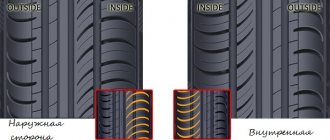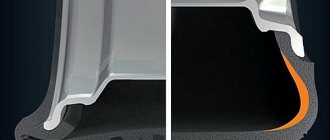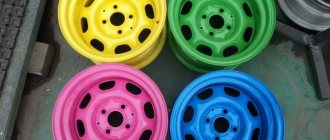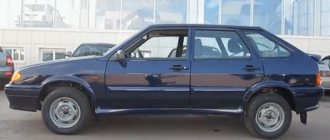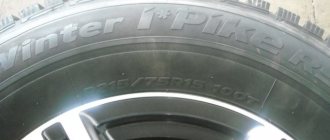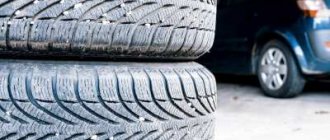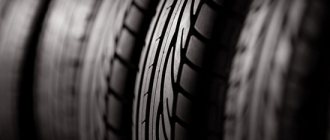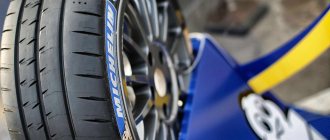Expert Alexey Zayakin talks about the secrets of the functionality of modern winter wheels .
Friction (non-studded) winter tires are often called “Velcro” in driver’s slang. There is no exact information about the origin of this popular name, but it can be assumed that it was formed when the first imported tires of this type began to enter the Soviet-Russian market in the late eighties and early nineties of the last century. Drivers of the time were so delighted with the level of grip that studless tires had never experienced before that they began to call them “Velcro.” With this name they conveyed the meaning that the tire seemed to “stick” to a slippery road and held the car well. The opposite of Velcro are studded tires - winter tires equipped with anti-skid studs.
Friction tire. Photo: Shutterstock.com
Principle of operation
A friction tire or “Velcro” is a class of winter tire that can cling to the ice surface without metal inserts. If in studded tires the interaction between the slippery coating and the tread consists of friction of the rubber and adhesion by the studs, then in friction tires only the friction force is used. The grip of a wheel on the road largely depends on the tread pattern. The greater their number and the total length of the edges in the contact patch, the better the wheel will handle the winter road. When accelerating, the rear edge of the tread block is used, and when braking, the front edge is used.
A heated winter tire can melt the ice structure. This is clearly evidenced by tread marks on the icy surface. The principle of operation of the Velcro protector is to remove (absorb) a thin film of water that forms between the icy surface and heated rubber, resulting in dry or semi-dry friction. The thickness of the water film is affected by air temperature and ice structure, so the traction properties of a tire depend entirely on climatic conditions. The lower the temperature drops in winter, the more effective the use of friction rubber is.
There is only one drawback, but a very significant one.
However, friction rubber also has its disadvantages. Velcro is intended for hard surfaces only. On soft and slippery surfaces, such as ice and packed snow, they are noticeably inferior to winter spikes. “Black ice” that forms at near-zero temperatures is especially dangerous for friction tires. It has a very low coefficient of adhesion and is sometimes covered with a microscopic layer of water, which, when mixed with snow and ice chips, instantly clogs the lamellas and reduces the adhesion properties of the rubber. The car can skid unpredictably even in a slight turn. Moreover, it will be extremely difficult to stop its chaotic movement. It is precisely because of the unpredictability of behavior on smooth ice that drivers traveling long distances in winter do not trust Velcro and try to use studded wheels. In such situations, studs allow you to better control the car and cope with possible skidding.
In general, friction rubber with a large number of sipes rides best on asphalt and is designed for life in large cities with good road infrastructure. She has no equal here.
Features of the Velcro splint
The functional features of Velcro are provided by the special properties of rubber and the special texture of the tire surface:
- a large number of lamellas;
- softness of materials;
- porous structure;
- abrasive microparticles.
All friction tires are connected by an increased number of lamellas. The lamella is a thin strip of rubber into which the tread is divided. This separation increases the pressure on the coating, resulting in improved adhesion. The following types of lamellas are distinguished:
- transverse;
- diagonal;
- zigzag.
The Velcro protector is equipped with lugs, like any other self-cleaning protector. The difference lies in the increased density of the arrangement, which has a positive effect on mileage, allowing the use of a larger number of lamellas. It is the edges of the tire sipes that cling to the surface, and in combination with the large tread depth, a stable and large contact patch is formed.
Under the weight of the car, the lamellas in the tread blocks diverge, which literally sticks to the surface of the snow-covered road surface. When leaving the contact zone with the road, the sipes converge and the tire self-cleans, displacing crushed ice and snow. But the lamellas are far from the only important condition. No matter how many of them are provided, maximum adhesion efficiency can only be ensured by the porous structure of the rubber. It is this that will absorb water when hitting the road surface.
The composition of the Velcro rubber includes a cryosilane mixture with silica, so it does not become rough at low temperatures, and a large number of micropores remove the water film. At the molecular level, each pore of the tire interacts with the road surface according to the suction cup principle, which provides not only an effective traction function, but also a short braking distance. At the same time, many manufacturers claim the addition of solid microparticles of inorganic and organic origin to the rubber mixture. Such abrasives perform the function of unique mini-spikes, which only enhances the friction properties.
Winter tire models
- Tires Goodyear UltraGrip Cargo Seasonality: summer Spikes: yes Diameter: 15 / 16 / 17
Read more - Yandex.Market rating: Yandex.Market: 4.5
Goodyear UltraGrip Ice 2 tires
Seasonality: winter Spikes: no Diameter: 15 / 16 / 17 / 18 / 19
More details
- Yandex.Market rating: Yandex.Market: 4.5
Goodyear UltraGrip Ice SUV Tires
Seasonality: winter Spikes: no Diameter: 16 / 17 / 18 / 19 / 20 / 21
More details
- Yandex.Market rating: Yandex.Market: 4.5
Goodyear UltraGrip Ice+ tires
Seasonality: winter Spikes: no Diameter: 15 / 16 / 17
More details
- Goodyear UltraGrip Arctic 2 tires
Seasonality: winter Spikes: yes Diameter: 16 / 17 / 18 / 19
More details
- Yandex.Market rating: Yandex.Market: 4.5
Goodyear UltraGrip Performance Gen-1 Tires
Seasonality: winter Spikes: no Diameter: 16 / 17 / 18 / 20 / 21
More details
- Yandex.Market rating: Yandex.Market: 4
Goodyear UltraGrip Performance 2 Tires
Seasonality: winter Spikes: no Diameter: 16 / 17 / 21
More details
- Goodyear UltraGrip Ice 2+ tires
Seasonality: winter Spikes: no Diameter: 17 / 19 / 20
More details
The weak point of the “Scandinavians” is that the tires are too soft. The tread of such a tire wears out faster than that of a European tire; in addition, a tire that is too soft begins to “walk” on hard surfaces. Drivers note slow reactions to turns and sudden maneuvers when moving from virgin snow to asphalt.
Scandinavian tires are designed for trips outside the city, on snowy streets or highways. There is nothing to do in the city with such tires.
Types and features of friction tires
Depending on their performance characteristics, friction tires are divided into Nordic and European. This is a conditional division; there is no such marking on the tire. Velcro of the Nordic type differs from the “European” type by the following features:
- A large number of deep slats. Compared to European friction rubber, the sipes are cut to almost the entire tread depth. Thanks to this, the tread blocks open and simulate the tire sticking to the surface.
- No tenon/tenon hole.
- Low speed index. “Scandinavians” are less stable at high speeds due to the dense cutting of the sipes and deep tread. As a rule, the speed limit varies between 160-190 km/h.
- The soft composition of the rubber compound ensures that elasticity is not lost at extremely low temperatures.
- Nordic friction tires are designed for cold winters with frequent snowfalls, while “European” tires do not tolerate frost and require more gentle conditions - clean roads treated with deicing agents.
What is better in winter: spikes or Velcro
Tires with studs.
Based on the design features of studless tires, it is not difficult to guess about their features. In particular, marketing benefits include:
- Constant fuel consumption;
- Durability;
- Reducing vibrations and, as a result, noise in the cabin.
But all these properties are noticeable in wet weather and are much worse on untreated icy roads or on snowy surfaces; here such tires can lose to classic studded tires in handling and cross-country ability. Naturally, the spikes will also benefit from braking on ice. At the same time, on snowless and wet asphalt, the spikes will slip over the surface and behave in a radically opposite way.
Also, the characteristics of driving on ice may depend on the temperature: if it is not frozen enough, the friction rubber will push through it, and there will be no suction effect. When the temperature reaches -20 degrees Celsius, friction rubber will perform better on ice; in addition, it is noted that at extremely low temperatures it will feel a little less dull than studded tires.
Features of using Velcro in different conditions:
- Snow . Here the grip will depend only on the tread depth. A non-aggressive texture will reduce traction, but it is important to test tires for self-cleaning capabilities, otherwise the tire may dig in and be unable to handle large amounts of snow.
- Rolled snow surface . Perhaps the most unloved type of road by drivers is where the situation is aggravated by a crust of ice. Here the velcro will be predominantly lamella, although the tread and softness of the compound also play a role. But the efficiency will not be as high as with the use of spikes.
- Summer asphalt etc. Despite the fact that we are talking about winter tires, we cannot help but mention the peculiarities of behavior in summer. At first glance, many drivers do not notice the difference in handling and are in no hurry to “change shoes” of the car. However, the softness of the material is only useful at low temperatures: on summer asphalt, such rubber has worse grip. As a result, the braking distance increases, and the response to “taxiing” decreases. Driving on a wet road is especially dangerous: tests showed “floating” already at a speed of 70 km/h. Tire wear also increases significantly, which is why a set used until late spring may not survive until the new winter period.
As you can see, there is no clear advantage of Velcro over studded wheels. These tires are more versatile: they are perfect for the city. Also, one cannot fail to mention the advantages of Velcro during transition periods, where stud owners face a dilemma: let the summer tires harden when it freezes or hear a grinding sound on the asphalt after thawing. And in general, modern branded Velcro from top manufacturers will be little inferior to studded tires even on ice, although the price of such a kit will be very high. But in snowy countryside with poor cross-country ability, many drivers prefer studs: they are cheaper and more optimal for off-road use.
Features of the use of Velcro
The legal requirements for the winter class of tires are the same for both studded and friction tires. Between December and February, vehicles must be equipped with winter tires bearing a mountain peak icon with a snowflake and the lettering "MS", "M&S" or "M+S". In this case, the remaining tread height should be more than 4 mm. The requirement for a vehicle to have a sign with the letter “Ш” does not apply to friction tires.
It is important that this technical regulation prohibits the use of studded tires in the summer, but there is no direct ban on the use of Velcro during the same period. However, this does not mean that the tire can be considered all-season: its characteristics are designed for the winter period, and operation on hot asphalt will lead to a loss of adequate controllability and accelerate wear. It is worth remembering that during the first 100-150 km the friction tires are broken in. This distance is enough to erase the film of lubricant that was applied before vulcanization. The optimal speed during the break-in period is no more than 80 km/h. The slats will sharpen in the direction of travel, so you should not brake sharply or make other sharp maneuvers. Otherwise, damage to the tread is inevitable.
During further operation, such sharp maneuvers are also undesirable: the rubber of friction tires is soft and therefore wears out quickly. Installation of the old set for the next season should be carried out in compliance with the direction of rotation that was previously.
What is Velcro rubber
Tires with Velcro.
Velcro is the colloquial name for studless rubber, which has just begun to take root in our country. If we return to the correct name, it will be based on the English term “friction”. As you might guess, translated this means “friction”, and rubber is called friction rubber.
Thus, while the key feature of studded tires is engaging solid elements, the main focus of friction tires will be on creating friction. And here this is achieved with a radically opposite approach: instead of hard tweezers, a soft mixture with a large number of pores is used.
For many drivers, this type of tire causes some mistrust: are such tires suitable for our roads at all? The fact is that they were originally developed in Europe, where, in addition to a comfortable winter, the roads are always well maintained and it is quite difficult to encounter ice on your way. Nevertheless, the situation is gradually changing in our country, as more and more road services are trying to resort to special reagents that cover asphalt. Such sprayers not only dissolve snow, but also cover the road surface with a film of grease, which further prevents the growth of ice.
see also
- Winter tires in Elets shin shinich
- Winter tires for Mercedes E class
- Winter tires for Kia Rio 2010
How to change tires for winter correctly- Opel Vectra with winter tires
Winter tire tests 215 65 r16- Winter tires bridgestone ice cruiser 5000
- Winter tires for Mitsubishi Pajero Sport
- Winter tires for Volkswagen Polo 2017
- Winter tires hankook 205 55 r16
- Winter tires are mandatory from December 1st
Advantages and disadvantages
No type of tire can be called ideal. Below we will list both the disadvantages and advantages of friction tires. Pros :
- comfortable and soft ride;
- preservation of properties in the cold;
- good road handling;
- Possibility of use in the off-season;
- effective self-cleaning;
- improved water removal;
Minuses:
- poor handling on packed snow;
- disproportionate wear;
- need for break-in.
Attention! During the first kilometers, the car must be driven carefully, without making sudden maneuvers.
Useful to read : Monitoring tire pressure
Buy correctly, don't get confused
In conclusion, I would like to note that many of us confuse the friction tire with the so-called EUROZIN , and then tell everyone that this “Velcro doesn’t work at all,” but this is not entirely true. EUROZIMA is designed for a very mild climate, literally for several days or weeks of not so low sub-zero temperatures, and its operation is also recommended on cleared and well-maintained roads - THIS IS A COMPLETELY DIFFERENT RUBBER. Don't confuse it with real winter!
Now let's watch a short video of the work.
I’ll finish this, I think the article and video were useful to you. Sincerely yours, AUTOBLOGGER.
Similar news
- How are wheels made? Let's analyze an ordinary car + detailed video
- Unwelding. What is it, main pros and cons. How to make a s…
- How to choose winter tires for a car. 8 right steps! Pl...
Add a comment Cancel reply
Marking
Sometimes the marking of all-season tires can be supplemented with various icons. Among the additional symbols you can find the inscription “Retread”. The fact is that some kits need to be repaired and the compound is re-fused onto them and the tread is cut. Refurbished products carry this designation. Driving on such tires does not pose any danger, but the tire purchased by the driver will wear out a little earlier. Fortunately, the price is cheaper.
Some car tires and wheels do not fit together, having fundamental differences in design. So, if you are going to change the tires of your car yourself, it is worth remembering that the tube sets must be installed on the corresponding wheels with the designations LK, GK or RK. The symbols LB, GB or RB indicate combination with tubeless type kits (TubeLess).
Tire installation rules regulate the presence of color marks. If there is a yellow triangle icon on the sidewall, then this is the lightest part of the rubber. All you need to do is align it with the mark on the disc. The red dot indicates the hardest point and should also be aligned with the L mark on alloy wheels.
